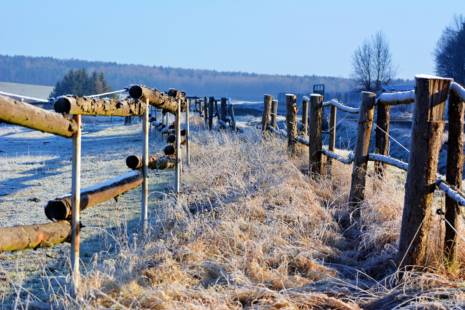Wednesday 7th February, 2018

Fields and fencing take a considerable battering over the winter months, with arctic showers and icy blasts pummelling paddocks across the UK. Even if your horses are kept safe and snug indoors for the majority of the time, you need to ensure that they are safe and secure when turned out, no matter how briefly. Here we look at why you need to put fencing first this February.
A breach in the borders around your field is dangerous on many counts. Firstly, you risk your horse escaping on to busy roads or neighbouring land. Secondly, you jeopardise his safety should he become trapped or injured by broken fencing, and thirdly you increase the risk of theft due to easy access to your field. Furthermore, any thefts or injuries that occur due to a fencing failure may invalidate your liability or veterinary insurance and could leave you with a hefty bill.
Well, first off you need to be checking the perimeter of your field for any weak spots. Breaks in post and rail fencing are relatively easy to see even at a distance, but wire fencing will require more thorough inspection. Look out for any holes in sheep wire fencing that horses could easily trap a foot in, check for slack strands of electric tape that he could become entangled in or splintered rails that could cause impaling accidents. If your field contains mobile or fixed field shelters, you will also need to check their condition. Modern good quality field shelters will have pre-treated timber that can withstand harsh winters. If your current shelter is compromised in any way then make the move to replace it as a priority.
Ideally, horse owners should be checking their perimeters on a daily basis. However, this is simply not feasible for most owners, both due to work commitments or the size of the paddock itself. If the grazing is a large area inaccessible by road or the owners only visit the field at dusk or dawn, then inspection of the fencing is going to prove tricky. Try and check the hedges and fences bordering your field at least once a month, if not weekly if you can manage it. Note that livery yard owners have a responsibility to check and maintain all fences, gates and borders also.
If you identify broken fencing in your field you must notify your yard owner or fellow stable mates and move any horses occupying the field to alternative grazing immediately. If no other paddocks are available you will need to stable your horses until the site is secure. Remaining in the paddock with inadequate fencing endangers the safety of your horse, and the safety of others should he escape. Don’t leave your horse’s security slacking, make sure that your fences are in fine fettle this season.